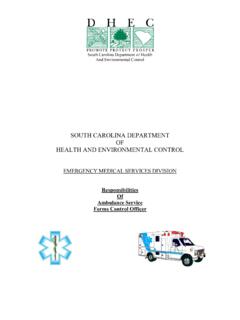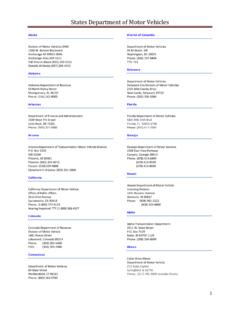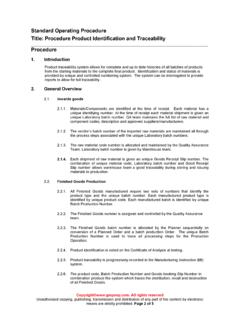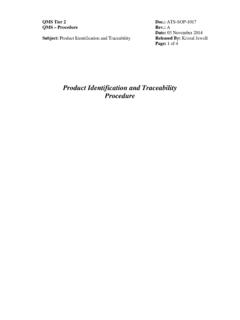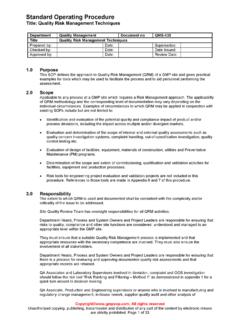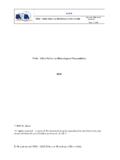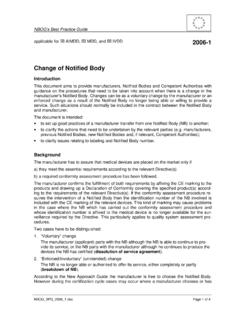Transcription of U.S. DEPARTMENT OF TRANSPORTATION - nhtsa.gov
1 TP-135-01. December 2, 2005. DEPARTMENT OF TRANSPORTATION . NATIONAL HIGHWAY TRAFFIC SAFETY ADMINISTRATION. LABORATORY TEST PROCEDURE. FOR. FMVSS 135. Light Vehicle Brake Systems ENFORCEMENT. Office of Vehicle Safety Compliance Room 6115, NVS-220. 400 Seventh Street, SW. Washington, DC 20590. 1. OVSC LABORATORY TEST PROCEDURE NO. 135. TABLE OF CONTENTS. PAGE. 1. PURPOSE AND 3. 2. GENERAL 4. 3. SECURITY .. 5. 4. GOOD HOUSEKEEPING .. 5. 5. TEST SCHEDULING AND MONITORING .. 5. 6. TEST DATA 5. 7. GOVERNMENT FURNISHED PROPERTY (GFP).. 6. 8. CALIBRATION OF TEST 7. 9. PHOTOGRAPHIC 8. 10. 9. 11. TEST EQUIPMENT AND REFERENCES .. 14. 12. PRETEST REQUIREMENTS .. 16. 13.
2 GENERAL TEST 17. 14. ROAD TEST PERFORMANCE REQUIREMENTS AND. COMPLIANCE TEST 26. 15. INSTRUCTIONS FOR COMPLETING DATA 63. 16. POST TEST 63. 17. REPORTS .. 64. 18. DATA 71. 19. FORMS (calibration and test equipment) .. 131. 20. APPENDIX 136. 1. 2. REVISION CONTROL LOG. FOR OVSC LABORATORY TEST procedures . TP-135-01 - LIGHT VEHICLE BRAKE SYSTEMS. Test Procedure FMVSS 135-01. Description Rev. No DATE AMMENDMENT EFFECTIVE. DATE. 00 10/29/97 60FR6411, 2/2/95 3/6/95 Original release, mandatory for PCs 9/1/00. 01 12/02/05 60FR37844, 7/24/95 8/23/95 Minor changes to test conditions 60FR44548, 8/28/95 8/28/95 Corrections to 7/24/95 final rule reg. text 62FR46907, 9/5/97 10/20/97 Amendments for brake systems of electric vehicles 62FR51064, 9/30/97 12/1/97 Standard extended to LTV's GVWR 3,500 kg, mandatory 9/1/2002.
3 65FR6327, 2/9/00 3/27/00 Minor changes to test conditions, vehicles with regenerative braking 70FR37706, 6/30/05 6/30/05 Minor correction to (b). 2. 3. 1. PURPOSE AND APPLICATION. The Office of Vehicle Safety Compliance (OVSC) provides contractor laboratories with Laboratory Test procedures as guidelines for obtaining compliance test data. The data are used to determine if a specific vehicle or item of motor vehicle equipment meets the minimum performance requirements of the subject Federal Motor Vehicle Safety Standard (FMVSS). The purpose of the OVSC Laboratory Test procedures is to present a uniform testing and data recording format, and provide suggestions for the use of specific equipment and procedures .
4 These Laboratory Test procedures do not constitute an endorsement or recommendation for use of any product or method. If any contractor views any part of an OVSC Laboratory Test Procedure to be in conflict with a FMVSS or observes deficiencies in a Laboratory Test Procedure, the contractor is required to advise the Contracting Officer's Technical Representative (COTR) and resolve the discrepancy prior to the start of compliance testing. The OVSC Laboratory Test procedures are not intended to limit or restrain a contractor from developing or utilizing any testing techniques or equipment which will assist in procuring the required compliance test data. However, the application of any such testing technique or equipment is subject to prior approval of the COTR.
5 NOTE: The OVSC Laboratory Test procedures , prepared for the limited purpose of use by independent laboratories under contract to conduct compliance tests for the OVSC, are not rules, regulations or nhtsa . interpretations regarding the meaning of a FMVSS. The Laboratory Test procedures are not intended to limit the requirements of the applicable FMVSS(s). In some cases, the OVSC Laboratory Test procedures do not include all of the various FMVSS minimum performance requirements. Recognizing applicable test tolerances, the Laboratory Test procedures may specify test conditions that are less severe than the minimum requirements of the standard. In addition, the Laboratory Test procedures may be modified by the OVSC at any time without notice, and the COTR.
6 May direct or authorize contractors to deviate from these procedures , as long as the tests are performed in a manner consistent with the standard itself and within the scope of the contract. Laboratory Test procedures may not be relied upon to create any right or benefit in any person. Therefore, compliance of a vehicle or item of motor vehicle equipment is not necessarily guaranteed if the manufacturer limits its certification tests to those described in the OVSC Laboratory Test procedures . 3. 4. 2. GENERAL REQUIREMENTS. This standard applies to vehicles with a gross vehicle weight rating (GVWR) of 3500 kg ( 7716 lbs.) or less. Standard 135 specifies requirements for service brake and associated parking brake systems in order to insure safe braking performance under normal and emergency driving conditions.
7 The service brakes shall be capable of stopping each vehicle in a series of tests within specific distances, speeds, brake pedal forces, and/or decelerations. Vehicles shall be capable of stopping under partial failure of the service brake system, inoperative brake power assist unit or brake power unit, antilock failure, variable proportioning valve failure, and with the engine off. Braking capability during and after exposure to the high brake temperatures caused by prolonged or severe use is also evaluated. Tests are conducted to evaluate whether vehicles not equipped with antilock brakes, are front biased with lockup of both front wheels occurring simultaneously or at a lower deceleration rate then the rear wheels.
8 Vehicles which are not front biased are additionally tested for adhesion utilization to ensure that the vehicles brake system is able to utilize the available adhesion at the tire-road interface. Additional requirements must be met for electric vehicles and for vehicles equipped with electrically actuated brakes. Each vehicle shall be manufactured with a parking brake system which, when engaged, shall be capable of holding the vehicle stationary on a specified grade for a specified time. Each vehicle shall have one or more brake system indicator lamps mounted in front of and in clear view of the driver. Indicator lamps shall be activated both when certain vehicle conditions occur and when the ignition switch is turned to a certain position as a check of lamp function.
9 Each vehicle shall have a specific brake fluid warning statement located on or near the brake fluid reservoir filler plug or cap. Each vehicle shall be capable of completing all performance requirements without detachment or fracture of any component of the braking system and without any visible brake fluid or lubricant on the friction surface of the brake, or leakage at the master cylinder or brake power unit reservoir cover, seal, or filler openings. 5. 3. SECURITY. The contractor shall provide appropriate security measures to protect the OVSC. test vehicles and parts during the entire compliance testing program. The contractor is also financially responsible for any acts of theft and/or vandalism which occur during the storage of test vehicles.
10 Security problems which arise shall be reported by telephone to the COTR and the Industrial Property Manager (IPM), Office of Contracts and Procurement (OCP), within 2 working days after the incident. A letter containing specific details of the security problem shall be sent to the IPM (with copy to the COTR) within 4 working days. The contractor shall protect and segregate all photographs and data that evolve from compliance testing. No information concerning the vehicle safety compliance testing program shall be released to anyone except the COTR, unless specifically authorized by the COTR or the COTR's Branch or Division Chief. NO INDIVIDUALS, OTHER THAN CONTRACTOR PERSONNEL DIRECTLY.






